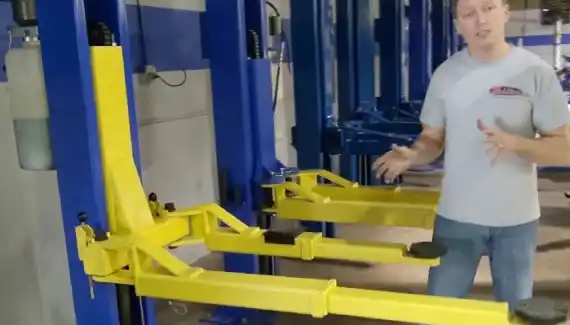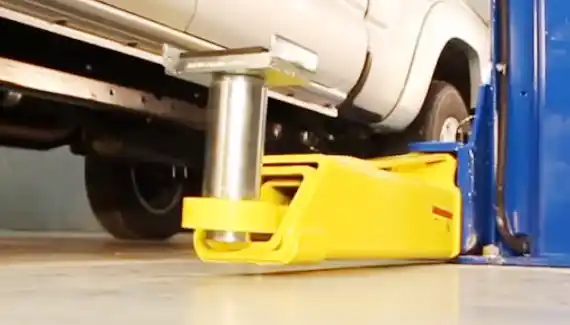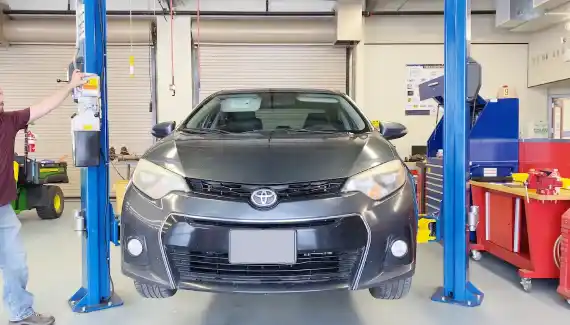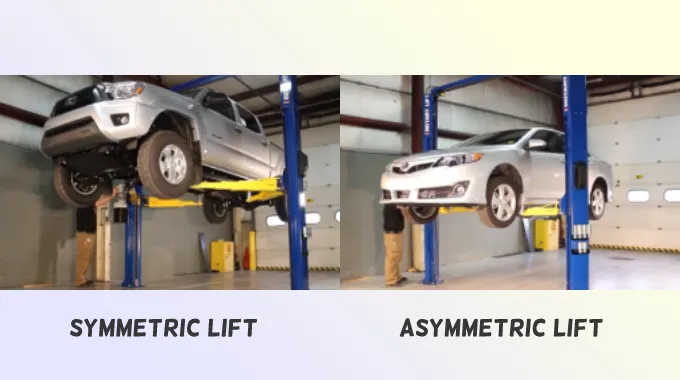Last Updated on April 12, 2023
Whether you’re a hobbyist looking for a reliable way to lift your car, symmetric and asymmetric lifts are the two most popular choices. But which one should be part of your toolkit for success?
When choosing between symmetric vs asymmetric lifts, you should consider arm’s length, space requirements, lifting stability, capacity, ease of installation and operation, versatility in usage options, and safety features.
Symmetric lifts offer equal weight distribution with four arms all the same length for better balance and stability. With asymmetric lifts, you can stabilize your vehicle. The two long arms mean a bit more space is required for setup, but that’s a small price to pay when it comes to reliable support at an affordable cost.
Let’s get up close and personal with these two types of lifts. We’ll explore their features, compare them, and dissect why some people may lean toward one another.
Symmetric vs Asymmetric Lift For Home Garage: Comparison

When it comes to lifting your heavy garage items, the deciding factor of which lift system to choose: symmetric or asymmetric, is a critical one. Let’s dive in and explore some aspects that might come as a surprise to what you find.
1. Arms Length:
Symmetric lifts have four arms of equal length, while asymmetric lifts have two short arms at the front and two long arms at the back.
They feature arms that are equal in length, allowing for easy access to the underside of the vehicle from all sides. This makes them ideal for a variety of tasks, including oil changes, brakes, and suspension work, as well as other general maintenance tasks.
Asymmetric lifts, on the other hand, feature arms that are not equal in length, providing more access to one side of the vehicle more than the other. This type of car lift is typically used for more specialized services such as transmission work or bodywork repairs.
2. Space Requirements:
Symmetric lifts generally require less space than asymmetric ones since their arms are distributed evenly. It allows them to be used in tight spaces without sacrificing performance or safety.
Asymmetric lifts require a slightly larger area due to their unequal arm lengths. This extra space allows for greater maneuverability when accessing different parts of the vehicle more easily with an asymmetric lift compared to a symmetric one.
3. Lifting Speed:
The speed at which a lift can operate is another important factor when choosing which type is best suited for your needs.
Symmetrical two-post lifts are faster than asymmetrical ones since their arms are spread out evenly and don’t need to adjust as much when lifting or lowering the car. Their even arm lengths distribute pressure evenly across both sides of the arm when lifting or lowering an object or a vehicle
Asymmetrical models are slower because they must adjust their arms depending on which side requires access first. There is usually an uneven weight distribution across one side due to its longer arm length compared to the shorter one found in symmetrical models.
This can result in longer wait times if you deal with multiple angles during your repair or service job.
4. Lifting Stability:
Symmetrical two-post lift designs offer better stability than their asymmetrical counterparts due to their even distribution of weight across all four corners. This helps reduce any potential swaying or wobbling during operation caused by unevenly distributed weight loads common with asymmetrical designs.
5. Lifting Capacity:

While both can lift cars and other vehicles, symmetric lifts have a higher maximum lifting capacity than asymmetric lifts.
Symmetric lifts typically have a maximum weight capacity of 10,000 lbs., while asymmetric lifts usually only have a maximum weight capacity up to 9,000 lbs. This makes symmetric lifts ideal for heavier cars and trucks, while asymmetric lifts are better suited for lighter vehicles such as sedans and SUVs.
Symmetric lifts allow you to lift the vehicle more efficiently since they can accommodate heavier loads without having to use additional jacks or stands.
6. Ease of Installation:
Symmetric lifts are generally easier to install and operate than asymmetric lifts due to their simpler design with fewer components.
Asymmetric lifts typically require more complex installation procedures, such as aligning two hydraulic rams at specific angles for optimal operation. In contrast, symmetrical designs require fewer parts and steps for installation.
The two posts are typically mounted directly onto the floor and connected by a single overhead beam.
Two post base plate lifts are more suitable for a home garage as they take up less space and can be installed without any special foundations or anchoring requirements. Some post base plate lifts may need stabilizing with weights or brackets depending on their size and weight capacity.
On the other hand, two post overhead lifts require more ceiling clearance but offer superior maneuverability as the arms can rise above the height of a car roof. They allow for easier access when carrying out repairs or maintenance tasks on hard to reach areas such as engine compartments and undercarriages.
7. Ease of Operation:
Symmetrical designs tend to be more intuitive to operate as they can be operated using only one control device. Having fewer parts in a symmetrical system means there is less potential for errors or malfunctions.
In contrast, asymmetrical designs usually require two separate devices in order to open and close the auto lift arms properly.
8. Flexibility:
Symmetrical lifts offer more flexibility when placing a vehicle on the lift as they can be placed backwards or forwards depending on preference. Their adjustable arm widths easily accommodate different vehicle sizes without having to reconfigure the entire system each time.
9. Versatility in Usage Options:

Symmetric lifts provide a higher degree of versatility compared to their asymmetrical counterparts due mostly to their greater weight capacity and improved mobility options.
With an asymmetrical design, it may be difficult or impossible to perform certain tasks such as parallel parking or lifting heavier vehicles, due to its limited range of motion.
On the other hand, symmetrical designs allow for greater maneuverability due to its larger weight capacity and improved reach range between its arms. When lifting larger objects that are not supported by an asymmetrical system’s arms alone.
10. Safety Features:
Symmetric lifts are generally considered safer due to their evenly balanced lifting arms, which make them less prone to tipping or jarring when a vehicle is loaded onto the lift.
With a symmetric lift, you typically get two independent points of lock release per side, one at the top and one at the bottom. This allows for greater flexibility when it comes to how much access an individual has to the vehicle.
An asymmetric car lift usually only has a single point of lock release at the top or bottom; this makes it more difficult to open from either end. Additionally, symmetric lifts tend to have larger platforms, making it easier to maneuver around and gain access to different parts of the vehicle.
11. Cost:
The cost of a symmetric or asymmetric auto lift can vary depending on several factors, such as type, size, and brand. Generally, initial purchase prices are typically higher for symmetric lifts than for asymmetric ones due to their increased complexity and structure.
They can be cost effective in the long run as they are designed to last longer and require less maintenance over time. Replacement parts are also easier to find for symmetric lifts since they use standard parts readily available in most auto part stores.
In terms of long-term maintenance costs, symmetric lifts tend to have lower running costs due to their sturdier construction.
Advantages of a Symmetrical Lift:

The symmetrical lift is an ideal choice for a home garage as it offers various advantages over other vehicle lifts available.
Homeowners can benefit from the versatility of a symmetrical lift, as it can accommodate vehicles of varying heights and types. Whether you own a car, SUV, truck, or something in between, a symmetrical lift is designed to handle each type safely and securely.
Certain models offer greater weight capacity and size range for heavier loads. With different specifications available for various tasks, you can be sure that your garage will be well-equipped for any job.
Disadvantages of a Symmetrical Lift:
Despite the many advantages offered by symmetrical lifts, there are also 3 drawbacks associated with them.
While symmetrical lifts are a great choice for many homeowners, they may be limited in certain areas. For instance, some designs may not provide the reach needed to complete certain service jobs.
Their size and shape make them difficult to install in some spaces or configurations. If specialized tools are required for specific tasks such as tire changes or oil changes, the selection may be limited due to the design of the lift itself.
Advantages of an Asymmetric Lift:
An asymmetrical vehicle lift has some advantages over symmetrical models, including increased reach capabilities and a wide variety of specialized tools. Many models are lightweight and offer greater customization options for individual needs.
An asymmetrical lift has increased reach capabilities compared to traditional symmetrical lifts. It’s easier to access difficult locations with greater precision and accuracy due to the flexibility afforded by this design.
These lifts offer a wider selection of specialized tools for specific automotive services like oil changes or tire rotations, which can help make servicing much simpler.
Many models are much lighter than their symmetrical counterparts. This makes them incredibly easy to transport and install in tight spaces like a home garage which may not have enough room for larger lifts.
There’s also a greater range of customization options available depending on individual requirements, such as height adjustments or LED lighting fixtures, or extended arms.
Disadvantages of an Asymmetric Lift
There are some downsides that should be considered before investing in an asymmetrical lift. These include lowered weight capacities compared to symmetrical models, as well as potential instability when lifting lighter vehicles due to uneven lifting surfaces.
The main disadvantage when using an asymmetrical lift in one’s home garage is its limited weight capacity compared to traditional symmetric lifts. As such, they aren’t suitable for heavier vehicles like SUVs or trucks which require more power for proper lifting capabilities.
Because these lifts often have uneven lifting surfaces, there may be issues with stability when attempting to lift lighter vehicles. It could lead to service delays or even cause damage if not dealt with properly.
What Are The 3 Types of Hoists for Automotive Lifts?

There are three main types of hoists commonly used for automotive lifts: two post lifts, four post lifts, and in-ground lifts.
Two post lifts are typically found in garage settings as they are easy to install and do not require major structural alterations. They can only safely support lighter vehicles, such as cars, due to their smaller size and lower capacity limit.
Four post lifts are heavier duty than two post lifts; they are usually found in commercial settings as they have larger capacities but require more floor space.
In-ground lifts require installation into cement floors but can safely support much heavier vehicles with their increased lifting capacity capabilities compared to the other options mentioned above.
What is the Weight Ratio for an Asymmetrical Lift?
The typical weight ratio for an asymmetrical 2 post lift lift is 30/70, meaning that the lift should distribute the weight of the vehicle evenly between two posts. This setup is intended to provide more stability when jacking up and lowering vehicles.
What Ceiling Height Is Needed for a 2 Post Lift?
In order to ensure maximum safety and performance when using a two post lift, it is recommended that garages have a minimum 11-12 feet clearance height. This allows plenty of room for the vehicle’s parts to be accessible while being lifted or lowered.
How Thick Should a Garage Floor Be for a Lift?
For garage floors that will be hosting either two post or four post lifts, the floor must have a minimum thickness of 4 inches. It can bear the weight of any potential vehicular load placed on top of it.
Symmetrical and Symmetrical: Decide Which is the Best for a Home Garage?
Whether you’re looking to install a new automotive lift system in your home garage or upgrade an existing setup, consider both symmetric and asymmetric options. When choosing between symmetrical and asymmetrical lifts for your home garage, carefully consider your needs and preferences.
Symmetric lifts offer uniformity with their four same-length arms while asymmetric lifts can provide greater versatility with their mix of short and long arms.
If you’re looking for a more flexible option that can accommodate both short-wheelbase vehicles and heavier ones, then a symmetrical lift is the best car lift.
On the other hand, if you primarily work on larger cars or trucks with a longer wheelbase, then an asymmetrical lift may be your best bet. Ultimately it’s up to you to decide which system best fits your needs.
